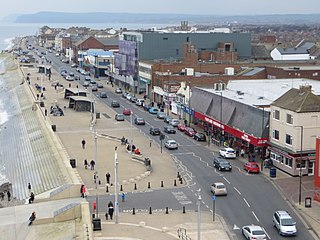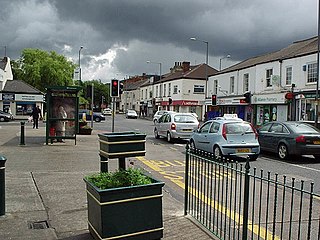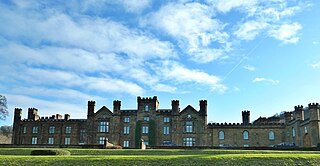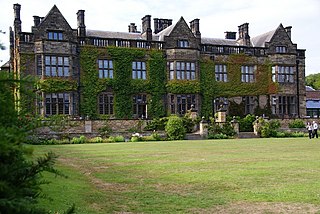
Eston is an area and former township in the borough of Redcar and Cleveland, North Yorkshire, England. It forms part of the Teesside built-up area's Middlesbrough sub-division.

Redcar is a seaside town on the Yorkshire Coast in the Redcar and Cleveland unitary authority in the county of North Yorkshire, England. It is located 7 miles (11 km) east of Middlesbrough.

Marske-by-the-Sea is a village in the unitary authority of Redcar and Cleveland and the ceremonial county of North Yorkshire, England. It is located on the coast, between the seaside resorts of Redcar and Saltburn-by-the-Sea, although it is not itself a seaside resort. Marske is in the civil parish of Saltburn, Marske and New Marske and comprises the wards of Longbeck and St Germains.

Teesville is an area in the borough of Redcar and Cleveland, North Yorkshire, England. It forms part of the Teesside built-up area's Middlesbrough sub-division.

Normanby is an area in the borough of Redcar and Cleveland, North Yorkshire, England. It forms part of the Teesside built-up area's Middlesbrough sub-division.

Ormesby is an area which is split between Borough of Middlesbrough and Borough of Redcar and Cleveland in North Yorkshire, England. It is in the Middlesbrough part of the Teesside built up area.

South Bank is a former township and an area on the south bank of the River Tees in the borough of Redcar and Cleveland, North Yorkshire, England. It is 2.5 miles (4.0 km) east of Middlesbrough town centre and 6.3 miles (10.1 km) south west of Redcar town centre. The area is served by South Bank railway station.

Wilton is a small village in Redcar and Cleveland, North Yorkshire, England. In 1951 the parish had a population of 958.

Brocket Hall is a neo-classical country house set in a large park at the western side of the urban area of Welwyn Garden City in Hertfordshire, England. The estate is equipped with two golf courses and seven smaller listed buildings, apart from the main house. The freehold on the estate is held by the 3rd Baron Brocket. The house is Grade I-listed.

Nunthorpe is a village, civil parish and locality in North Yorkshire, England. The parish and village are in the Borough of Middlesbrough with the locality in the borough of Redcar and Cleveland.

Grangetown is an area in the borough of Redcar and Cleveland, North Yorkshire, England. It forms part of the Teesside built-up area's Middlesbrough sub-division. The area is 3 miles (4.8 km) east of central Middlesbrough and 4 miles (6.4 km) from south-west of central Redcar.

Ingestre Hall is a Grade II* 17th-century Jacobean mansion situated at Ingestre, near Stafford, Staffordshire, England. Formerly the seat of the Earls Talbot and then the Earls of Shrewsbury, the hall is now owned by Sandwell Metropolitan Borough Council and is in use as a residential arts and conference centre.
The Cleveland Railway was a railway line in north-east England running from Normanby Jetty on the River Tees, near Middlesbrough, via Normanby and then via Guisborough through the Eston Hills, to Loftus in East Cleveland. It carried minerals from numerous iron ore mines along its route to the River Tees for shipment to Tyneside and elsewhere. The line was jointly proposed by the West Hartlepool Harbour and Railway (WHH&R), who provided half its capital, together with various landowners. The WHH&R lay on the north bank of the Tees, to which it had a cross-river connection via a jetty at Normanby.

Wilton Castle is an early 19th-century mansion, built on the site of a medieval castle, now converted into residential apartments, situated at Wilton, in Redcar and Cleveland, North Yorkshire, England. It is a Grade II listed building.

Gisborough Hall is a 19th-century mansion house, now a hotel, at Guisborough, Redcar and Cleveland, England. It is a Grade II listed building.

Down Hall is a Victorian country house and estate near Hatfield Heath in the English county of Essex, close to its border with Hertfordshire. It is surrounded by 110 acres (0.45 km2) of woodland, parkland and landscaped gardens, some of which is protected by the Essex Wildlife Trust.

The Grove is a large hotel in Hertfordshire, England, with a 300–acre (1.2 km2) private park next to the River Gade and the Grand Union Canal. It touches on its north-west corner the M25 motorway and remains a small part in Watford. The estate is situated within three different settlements; most of the land and all of the mansion itself are in the civil parish of Sarratt, and also in the ecclesiastical parish of Langleybury, while the estate lies within the post town of Rickmansworth.
Sir Charles Turner, 1st Baronet was a British politician and Lord Mayor of York.

Kilton Castle is a ruined castle overlooking the valley of Kilton Beck, near to the village of Kilton in the historic county of the North Riding of Yorkshire in England. The castle was built in the 12th century and was described as being in a ruinous state by the 14th century, with it being totally abandoned by the 16th century. Kilton Castle was owned by several noble families who hailed from the area; de Brus, de Kilton, Autrey, de Thweng, de Lumley.

Hutton Village is a settlement in the Hutton Lowcross area of Guisborough in North Yorkshire, England. Whilst the area itself is mentioned in the Domesday Book, the village was built largely due to the development of the ironstone industry in the Cleveland Hills. The name Hutton Lowcross referred to the township in the area, whereas the settlement is now known as Hutton Village. The village is set in a narrow dale that carries Hutton Beck northwards towards Guisborough.




















